Business Case: Trusty Carpets, Metro Carpets, and CRM Integration
VerifiedAdded on 2019/09/22
|5
|2403
|155
Case Study
AI Summary
This case study focuses on Trusty Carpets, a business facing challenges in integrating its various components (Trusty Carpets store, Metro Carpets store, and Mike's carpet installation business) into a unified operation. The core problem lies in the lack of a core communication and IT system, resulting in inefficiencies in sales, customer service, and overall operational management. The proposed solution is the implementation of SalesforceIQ CRM, a cloud-based customer relationship management software, to unify all three businesses under a single system. This solution aims to improve communication, streamline sales processes, enhance customer relationship management, and provide better control over sales and profitability. The analysis explores the organizational and operational feasibility of the proposed solution, including its integration into existing business processes, staffing needs, and retraining requirements. The case study highlights the potential for the CRM solution to address the core business problem, increase productivity, and ultimately improve the bottom line. The case study includes background information on the business, its current model, recent changes, opportunities, and how the proposed solution will help the business achieve its objectives.
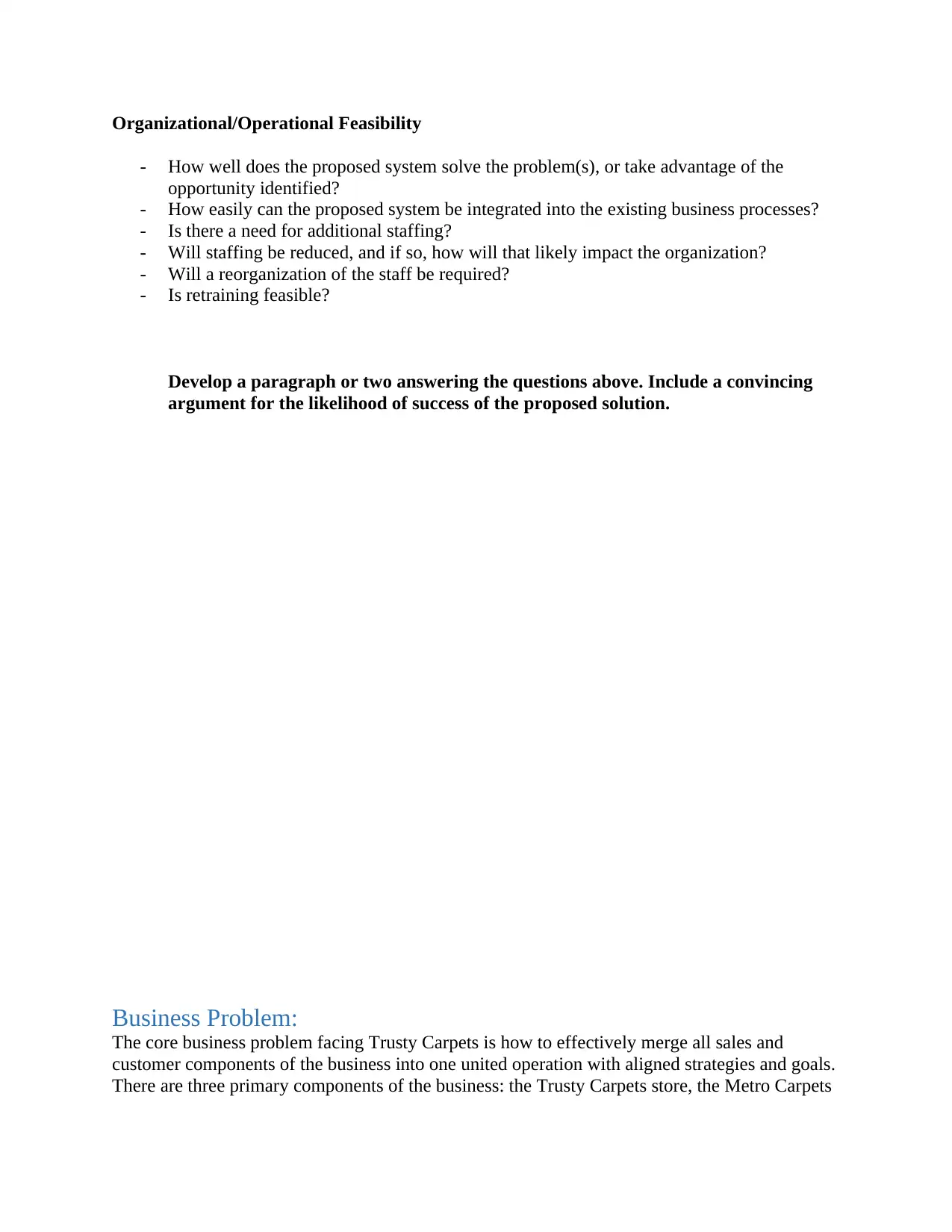
Organizational/Operational Feasibility
- How well does the proposed system solve the problem(s), or take advantage of the
opportunity identified?
- How easily can the proposed system be integrated into the existing business processes?
- Is there a need for additional staffing?
- Will staffing be reduced, and if so, how will that likely impact the organization?
- Will a reorganization of the staff be required?
- Is retraining feasible?
Develop a paragraph or two answering the questions above. Include a convincing
argument for the likelihood of success of the proposed solution.
Business Problem:
The core business problem facing Trusty Carpets is how to effectively merge all sales and
customer components of the business into one united operation with aligned strategies and goals.
There are three primary components of the business: the Trusty Carpets store, the Metro Carpets
- How well does the proposed system solve the problem(s), or take advantage of the
opportunity identified?
- How easily can the proposed system be integrated into the existing business processes?
- Is there a need for additional staffing?
- Will staffing be reduced, and if so, how will that likely impact the organization?
- Will a reorganization of the staff be required?
- Is retraining feasible?
Develop a paragraph or two answering the questions above. Include a convincing
argument for the likelihood of success of the proposed solution.
Business Problem:
The core business problem facing Trusty Carpets is how to effectively merge all sales and
customer components of the business into one united operation with aligned strategies and goals.
There are three primary components of the business: the Trusty Carpets store, the Metro Carpets
Paraphrase This Document
Need a fresh take? Get an instant paraphrase of this document with our AI Paraphraser
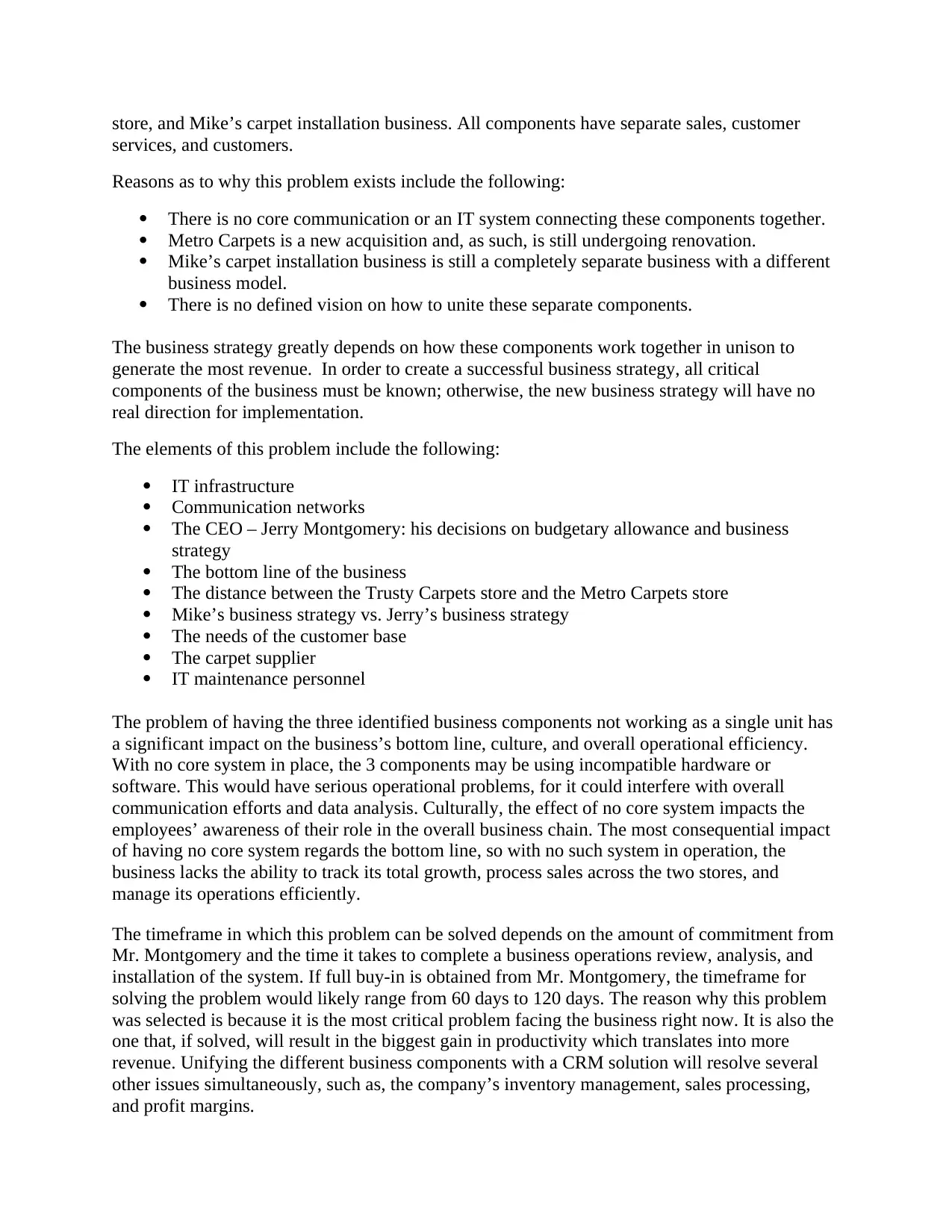
store, and Mike’s carpet installation business. All components have separate sales, customer
services, and customers.
Reasons as to why this problem exists include the following:
There is no core communication or an IT system connecting these components together.
Metro Carpets is a new acquisition and, as such, is still undergoing renovation.
Mike’s carpet installation business is still a completely separate business with a different
business model.
There is no defined vision on how to unite these separate components.
The business strategy greatly depends on how these components work together in unison to
generate the most revenue. In order to create a successful business strategy, all critical
components of the business must be known; otherwise, the new business strategy will have no
real direction for implementation.
The elements of this problem include the following:
IT infrastructure
Communication networks
The CEO – Jerry Montgomery: his decisions on budgetary allowance and business
strategy
The bottom line of the business
The distance between the Trusty Carpets store and the Metro Carpets store
Mike’s business strategy vs. Jerry’s business strategy
The needs of the customer base
The carpet supplier
IT maintenance personnel
The problem of having the three identified business components not working as a single unit has
a significant impact on the business’s bottom line, culture, and overall operational efficiency.
With no core system in place, the 3 components may be using incompatible hardware or
software. This would have serious operational problems, for it could interfere with overall
communication efforts and data analysis. Culturally, the effect of no core system impacts the
employees’ awareness of their role in the overall business chain. The most consequential impact
of having no core system regards the bottom line, so with no such system in operation, the
business lacks the ability to track its total growth, process sales across the two stores, and
manage its operations efficiently.
The timeframe in which this problem can be solved depends on the amount of commitment from
Mr. Montgomery and the time it takes to complete a business operations review, analysis, and
installation of the system. If full buy-in is obtained from Mr. Montgomery, the timeframe for
solving the problem would likely range from 60 days to 120 days. The reason why this problem
was selected is because it is the most critical problem facing the business right now. It is also the
one that, if solved, will result in the biggest gain in productivity which translates into more
revenue. Unifying the different business components with a CRM solution will resolve several
other issues simultaneously, such as, the company’s inventory management, sales processing,
and profit margins.
services, and customers.
Reasons as to why this problem exists include the following:
There is no core communication or an IT system connecting these components together.
Metro Carpets is a new acquisition and, as such, is still undergoing renovation.
Mike’s carpet installation business is still a completely separate business with a different
business model.
There is no defined vision on how to unite these separate components.
The business strategy greatly depends on how these components work together in unison to
generate the most revenue. In order to create a successful business strategy, all critical
components of the business must be known; otherwise, the new business strategy will have no
real direction for implementation.
The elements of this problem include the following:
IT infrastructure
Communication networks
The CEO – Jerry Montgomery: his decisions on budgetary allowance and business
strategy
The bottom line of the business
The distance between the Trusty Carpets store and the Metro Carpets store
Mike’s business strategy vs. Jerry’s business strategy
The needs of the customer base
The carpet supplier
IT maintenance personnel
The problem of having the three identified business components not working as a single unit has
a significant impact on the business’s bottom line, culture, and overall operational efficiency.
With no core system in place, the 3 components may be using incompatible hardware or
software. This would have serious operational problems, for it could interfere with overall
communication efforts and data analysis. Culturally, the effect of no core system impacts the
employees’ awareness of their role in the overall business chain. The most consequential impact
of having no core system regards the bottom line, so with no such system in operation, the
business lacks the ability to track its total growth, process sales across the two stores, and
manage its operations efficiently.
The timeframe in which this problem can be solved depends on the amount of commitment from
Mr. Montgomery and the time it takes to complete a business operations review, analysis, and
installation of the system. If full buy-in is obtained from Mr. Montgomery, the timeframe for
solving the problem would likely range from 60 days to 120 days. The reason why this problem
was selected is because it is the most critical problem facing the business right now. It is also the
one that, if solved, will result in the biggest gain in productivity which translates into more
revenue. Unifying the different business components with a CRM solution will resolve several
other issues simultaneously, such as, the company’s inventory management, sales processing,
and profit margins.
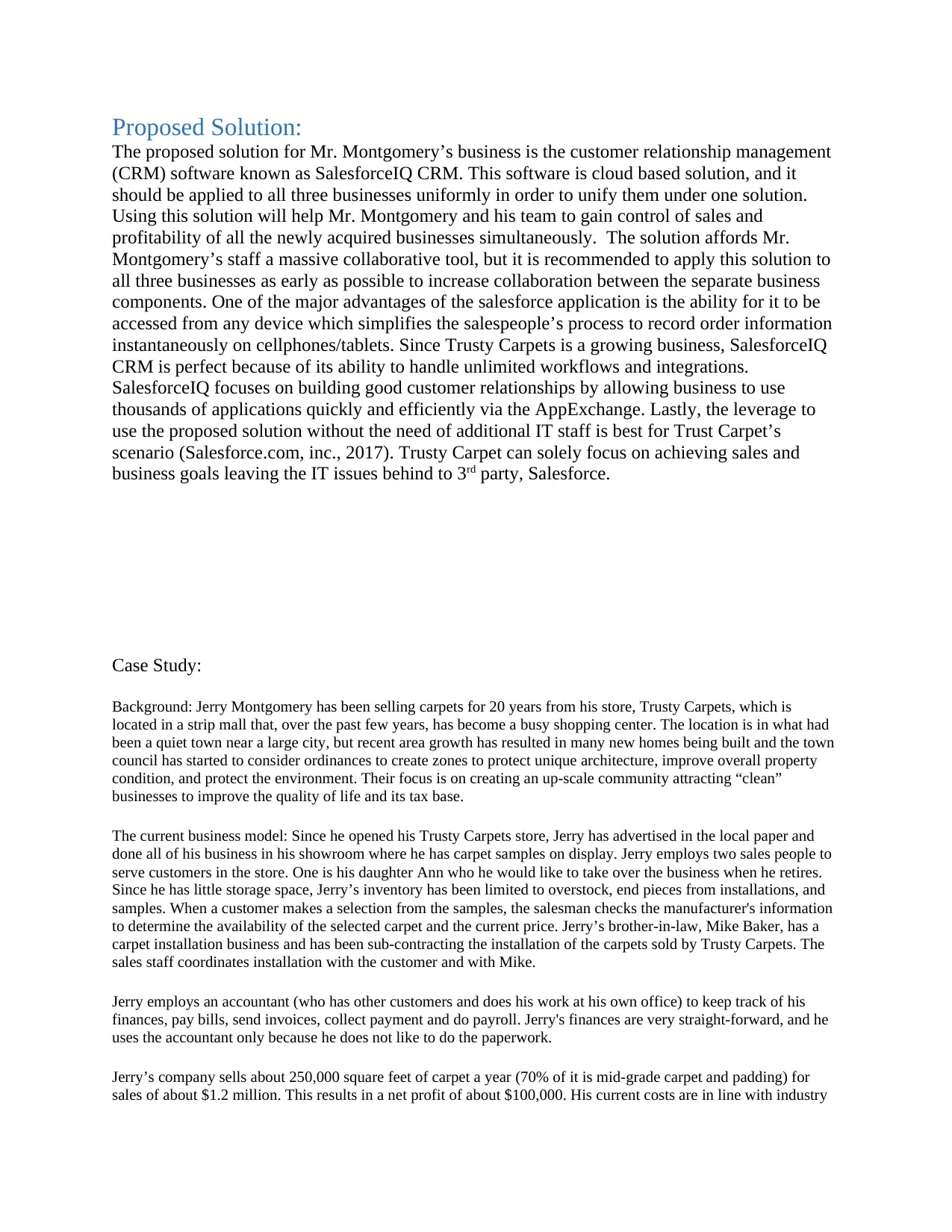
Proposed Solution:
The proposed solution for Mr. Montgomery’s business is the customer relationship management
(CRM) software known as SalesforceIQ CRM. This software is cloud based solution, and it
should be applied to all three businesses uniformly in order to unify them under one solution.
Using this solution will help Mr. Montgomery and his team to gain control of sales and
profitability of all the newly acquired businesses simultaneously. The solution affords Mr.
Montgomery’s staff a massive collaborative tool, but it is recommended to apply this solution to
all three businesses as early as possible to increase collaboration between the separate business
components. One of the major advantages of the salesforce application is the ability for it to be
accessed from any device which simplifies the salespeople’s process to record order information
instantaneously on cellphones/tablets. Since Trusty Carpets is a growing business, SalesforceIQ
CRM is perfect because of its ability to handle unlimited workflows and integrations.
SalesforceIQ focuses on building good customer relationships by allowing business to use
thousands of applications quickly and efficiently via the AppExchange. Lastly, the leverage to
use the proposed solution without the need of additional IT staff is best for Trust Carpet’s
scenario (Salesforce.com, inc., 2017). Trusty Carpet can solely focus on achieving sales and
business goals leaving the IT issues behind to 3rd party, Salesforce.
Case Study:
Background: Jerry Montgomery has been selling carpets for 20 years from his store, Trusty Carpets, which is
located in a strip mall that, over the past few years, has become a busy shopping center. The location is in what had
been a quiet town near a large city, but recent area growth has resulted in many new homes being built and the town
council has started to consider ordinances to create zones to protect unique architecture, improve overall property
condition, and protect the environment. Their focus is on creating an up-scale community attracting “clean”
businesses to improve the quality of life and its tax base.
The current business model: Since he opened his Trusty Carpets store, Jerry has advertised in the local paper and
done all of his business in his showroom where he has carpet samples on display. Jerry employs two sales people to
serve customers in the store. One is his daughter Ann who he would like to take over the business when he retires.
Since he has little storage space, Jerry’s inventory has been limited to overstock, end pieces from installations, and
samples. When a customer makes a selection from the samples, the salesman checks the manufacturer's information
to determine the availability of the selected carpet and the current price. Jerry’s brother-in-law, Mike Baker, has a
carpet installation business and has been sub-contracting the installation of the carpets sold by Trusty Carpets. The
sales staff coordinates installation with the customer and with Mike.
Jerry employs an accountant (who has other customers and does his work at his own office) to keep track of his
finances, pay bills, send invoices, collect payment and do payroll. Jerry's finances are very straight-forward, and he
uses the accountant only because he does not like to do the paperwork.
Jerry’s company sells about 250,000 square feet of carpet a year (70% of it is mid-grade carpet and padding) for
sales of about $1.2 million. This results in a net profit of about $100,000. His current costs are in line with industry
The proposed solution for Mr. Montgomery’s business is the customer relationship management
(CRM) software known as SalesforceIQ CRM. This software is cloud based solution, and it
should be applied to all three businesses uniformly in order to unify them under one solution.
Using this solution will help Mr. Montgomery and his team to gain control of sales and
profitability of all the newly acquired businesses simultaneously. The solution affords Mr.
Montgomery’s staff a massive collaborative tool, but it is recommended to apply this solution to
all three businesses as early as possible to increase collaboration between the separate business
components. One of the major advantages of the salesforce application is the ability for it to be
accessed from any device which simplifies the salespeople’s process to record order information
instantaneously on cellphones/tablets. Since Trusty Carpets is a growing business, SalesforceIQ
CRM is perfect because of its ability to handle unlimited workflows and integrations.
SalesforceIQ focuses on building good customer relationships by allowing business to use
thousands of applications quickly and efficiently via the AppExchange. Lastly, the leverage to
use the proposed solution without the need of additional IT staff is best for Trust Carpet’s
scenario (Salesforce.com, inc., 2017). Trusty Carpet can solely focus on achieving sales and
business goals leaving the IT issues behind to 3rd party, Salesforce.
Case Study:
Background: Jerry Montgomery has been selling carpets for 20 years from his store, Trusty Carpets, which is
located in a strip mall that, over the past few years, has become a busy shopping center. The location is in what had
been a quiet town near a large city, but recent area growth has resulted in many new homes being built and the town
council has started to consider ordinances to create zones to protect unique architecture, improve overall property
condition, and protect the environment. Their focus is on creating an up-scale community attracting “clean”
businesses to improve the quality of life and its tax base.
The current business model: Since he opened his Trusty Carpets store, Jerry has advertised in the local paper and
done all of his business in his showroom where he has carpet samples on display. Jerry employs two sales people to
serve customers in the store. One is his daughter Ann who he would like to take over the business when he retires.
Since he has little storage space, Jerry’s inventory has been limited to overstock, end pieces from installations, and
samples. When a customer makes a selection from the samples, the salesman checks the manufacturer's information
to determine the availability of the selected carpet and the current price. Jerry’s brother-in-law, Mike Baker, has a
carpet installation business and has been sub-contracting the installation of the carpets sold by Trusty Carpets. The
sales staff coordinates installation with the customer and with Mike.
Jerry employs an accountant (who has other customers and does his work at his own office) to keep track of his
finances, pay bills, send invoices, collect payment and do payroll. Jerry's finances are very straight-forward, and he
uses the accountant only because he does not like to do the paperwork.
Jerry’s company sells about 250,000 square feet of carpet a year (70% of it is mid-grade carpet and padding) for
sales of about $1.2 million. This results in a net profit of about $100,000. His current costs are in line with industry
⊘ This is a preview!⊘
Do you want full access?
Subscribe today to unlock all pages.

Trusted by 1+ million students worldwide
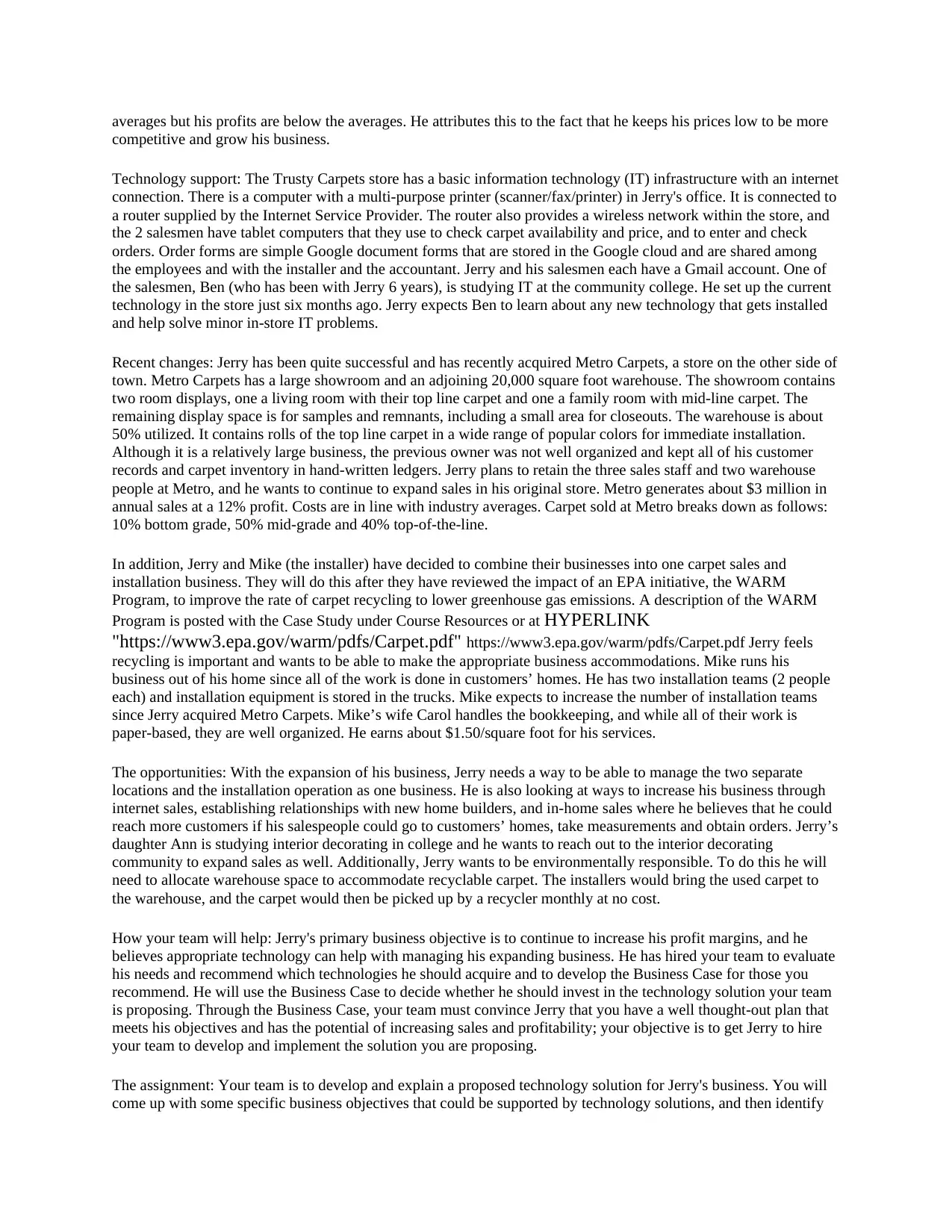
averages but his profits are below the averages. He attributes this to the fact that he keeps his prices low to be more
competitive and grow his business.
Technology support: The Trusty Carpets store has a basic information technology (IT) infrastructure with an internet
connection. There is a computer with a multi-purpose printer (scanner/fax/printer) in Jerry's office. It is connected to
a router supplied by the Internet Service Provider. The router also provides a wireless network within the store, and
the 2 salesmen have tablet computers that they use to check carpet availability and price, and to enter and check
orders. Order forms are simple Google document forms that are stored in the Google cloud and are shared among
the employees and with the installer and the accountant. Jerry and his salesmen each have a Gmail account. One of
the salesmen, Ben (who has been with Jerry 6 years), is studying IT at the community college. He set up the current
technology in the store just six months ago. Jerry expects Ben to learn about any new technology that gets installed
and help solve minor in-store IT problems.
Recent changes: Jerry has been quite successful and has recently acquired Metro Carpets, a store on the other side of
town. Metro Carpets has a large showroom and an adjoining 20,000 square foot warehouse. The showroom contains
two room displays, one a living room with their top line carpet and one a family room with mid-line carpet. The
remaining display space is for samples and remnants, including a small area for closeouts. The warehouse is about
50% utilized. It contains rolls of the top line carpet in a wide range of popular colors for immediate installation.
Although it is a relatively large business, the previous owner was not well organized and kept all of his customer
records and carpet inventory in hand-written ledgers. Jerry plans to retain the three sales staff and two warehouse
people at Metro, and he wants to continue to expand sales in his original store. Metro generates about $3 million in
annual sales at a 12% profit. Costs are in line with industry averages. Carpet sold at Metro breaks down as follows:
10% bottom grade, 50% mid-grade and 40% top-of-the-line.
In addition, Jerry and Mike (the installer) have decided to combine their businesses into one carpet sales and
installation business. They will do this after they have reviewed the impact of an EPA initiative, the WARM
Program, to improve the rate of carpet recycling to lower greenhouse gas emissions. A description of the WARM
Program is posted with the Case Study under Course Resources or at HYPERLINK
"https://www3.epa.gov/warm/pdfs/Carpet.pdf" https://www3.epa.gov/warm/pdfs/Carpet.pdf Jerry feels
recycling is important and wants to be able to make the appropriate business accommodations. Mike runs his
business out of his home since all of the work is done in customers’ homes. He has two installation teams (2 people
each) and installation equipment is stored in the trucks. Mike expects to increase the number of installation teams
since Jerry acquired Metro Carpets. Mike’s wife Carol handles the bookkeeping, and while all of their work is
paper-based, they are well organized. He earns about $1.50/square foot for his services.
The opportunities: With the expansion of his business, Jerry needs a way to be able to manage the two separate
locations and the installation operation as one business. He is also looking at ways to increase his business through
internet sales, establishing relationships with new home builders, and in-home sales where he believes that he could
reach more customers if his salespeople could go to customers’ homes, take measurements and obtain orders. Jerry’s
daughter Ann is studying interior decorating in college and he wants to reach out to the interior decorating
community to expand sales as well. Additionally, Jerry wants to be environmentally responsible. To do this he will
need to allocate warehouse space to accommodate recyclable carpet. The installers would bring the used carpet to
the warehouse, and the carpet would then be picked up by a recycler monthly at no cost.
How your team will help: Jerry's primary business objective is to continue to increase his profit margins, and he
believes appropriate technology can help with managing his expanding business. He has hired your team to evaluate
his needs and recommend which technologies he should acquire and to develop the Business Case for those you
recommend. He will use the Business Case to decide whether he should invest in the technology solution your team
is proposing. Through the Business Case, your team must convince Jerry that you have a well thought-out plan that
meets his objectives and has the potential of increasing sales and profitability; your objective is to get Jerry to hire
your team to develop and implement the solution you are proposing.
The assignment: Your team is to develop and explain a proposed technology solution for Jerry's business. You will
come up with some specific business objectives that could be supported by technology solutions, and then identify
competitive and grow his business.
Technology support: The Trusty Carpets store has a basic information technology (IT) infrastructure with an internet
connection. There is a computer with a multi-purpose printer (scanner/fax/printer) in Jerry's office. It is connected to
a router supplied by the Internet Service Provider. The router also provides a wireless network within the store, and
the 2 salesmen have tablet computers that they use to check carpet availability and price, and to enter and check
orders. Order forms are simple Google document forms that are stored in the Google cloud and are shared among
the employees and with the installer and the accountant. Jerry and his salesmen each have a Gmail account. One of
the salesmen, Ben (who has been with Jerry 6 years), is studying IT at the community college. He set up the current
technology in the store just six months ago. Jerry expects Ben to learn about any new technology that gets installed
and help solve minor in-store IT problems.
Recent changes: Jerry has been quite successful and has recently acquired Metro Carpets, a store on the other side of
town. Metro Carpets has a large showroom and an adjoining 20,000 square foot warehouse. The showroom contains
two room displays, one a living room with their top line carpet and one a family room with mid-line carpet. The
remaining display space is for samples and remnants, including a small area for closeouts. The warehouse is about
50% utilized. It contains rolls of the top line carpet in a wide range of popular colors for immediate installation.
Although it is a relatively large business, the previous owner was not well organized and kept all of his customer
records and carpet inventory in hand-written ledgers. Jerry plans to retain the three sales staff and two warehouse
people at Metro, and he wants to continue to expand sales in his original store. Metro generates about $3 million in
annual sales at a 12% profit. Costs are in line with industry averages. Carpet sold at Metro breaks down as follows:
10% bottom grade, 50% mid-grade and 40% top-of-the-line.
In addition, Jerry and Mike (the installer) have decided to combine their businesses into one carpet sales and
installation business. They will do this after they have reviewed the impact of an EPA initiative, the WARM
Program, to improve the rate of carpet recycling to lower greenhouse gas emissions. A description of the WARM
Program is posted with the Case Study under Course Resources or at HYPERLINK
"https://www3.epa.gov/warm/pdfs/Carpet.pdf" https://www3.epa.gov/warm/pdfs/Carpet.pdf Jerry feels
recycling is important and wants to be able to make the appropriate business accommodations. Mike runs his
business out of his home since all of the work is done in customers’ homes. He has two installation teams (2 people
each) and installation equipment is stored in the trucks. Mike expects to increase the number of installation teams
since Jerry acquired Metro Carpets. Mike’s wife Carol handles the bookkeeping, and while all of their work is
paper-based, they are well organized. He earns about $1.50/square foot for his services.
The opportunities: With the expansion of his business, Jerry needs a way to be able to manage the two separate
locations and the installation operation as one business. He is also looking at ways to increase his business through
internet sales, establishing relationships with new home builders, and in-home sales where he believes that he could
reach more customers if his salespeople could go to customers’ homes, take measurements and obtain orders. Jerry’s
daughter Ann is studying interior decorating in college and he wants to reach out to the interior decorating
community to expand sales as well. Additionally, Jerry wants to be environmentally responsible. To do this he will
need to allocate warehouse space to accommodate recyclable carpet. The installers would bring the used carpet to
the warehouse, and the carpet would then be picked up by a recycler monthly at no cost.
How your team will help: Jerry's primary business objective is to continue to increase his profit margins, and he
believes appropriate technology can help with managing his expanding business. He has hired your team to evaluate
his needs and recommend which technologies he should acquire and to develop the Business Case for those you
recommend. He will use the Business Case to decide whether he should invest in the technology solution your team
is proposing. Through the Business Case, your team must convince Jerry that you have a well thought-out plan that
meets his objectives and has the potential of increasing sales and profitability; your objective is to get Jerry to hire
your team to develop and implement the solution you are proposing.
The assignment: Your team is to develop and explain a proposed technology solution for Jerry's business. You will
come up with some specific business objectives that could be supported by technology solutions, and then identify
Paraphrase This Document
Need a fresh take? Get an instant paraphrase of this document with our AI Paraphraser
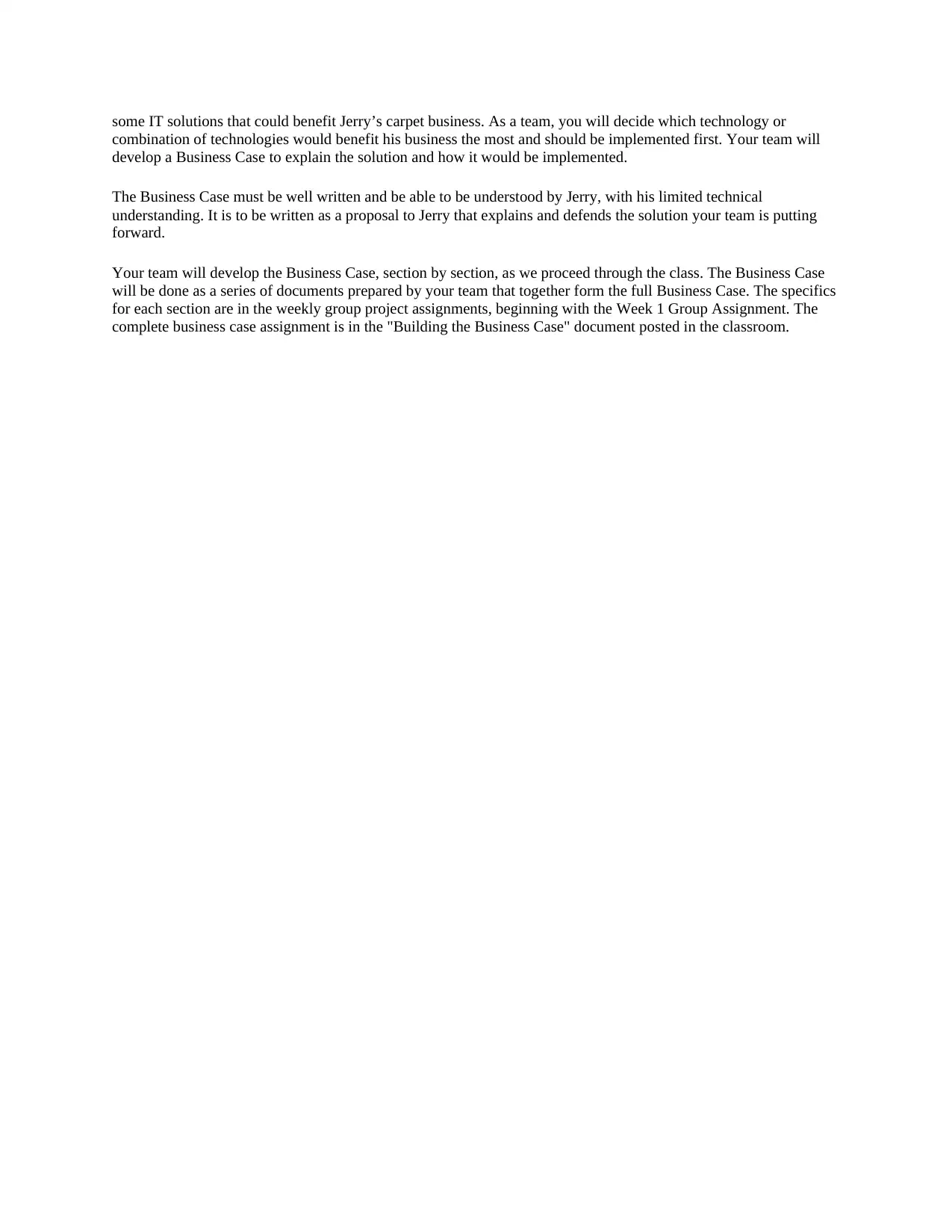
some IT solutions that could benefit Jerry’s carpet business. As a team, you will decide which technology or
combination of technologies would benefit his business the most and should be implemented first. Your team will
develop a Business Case to explain the solution and how it would be implemented.
The Business Case must be well written and be able to be understood by Jerry, with his limited technical
understanding. It is to be written as a proposal to Jerry that explains and defends the solution your team is putting
forward.
Your team will develop the Business Case, section by section, as we proceed through the class. The Business Case
will be done as a series of documents prepared by your team that together form the full Business Case. The specifics
for each section are in the weekly group project assignments, beginning with the Week 1 Group Assignment. The
complete business case assignment is in the "Building the Business Case" document posted in the classroom.
combination of technologies would benefit his business the most and should be implemented first. Your team will
develop a Business Case to explain the solution and how it would be implemented.
The Business Case must be well written and be able to be understood by Jerry, with his limited technical
understanding. It is to be written as a proposal to Jerry that explains and defends the solution your team is putting
forward.
Your team will develop the Business Case, section by section, as we proceed through the class. The Business Case
will be done as a series of documents prepared by your team that together form the full Business Case. The specifics
for each section are in the weekly group project assignments, beginning with the Week 1 Group Assignment. The
complete business case assignment is in the "Building the Business Case" document posted in the classroom.
1 out of 5
Related Documents
Your All-in-One AI-Powered Toolkit for Academic Success.
+13062052269
info@desklib.com
Available 24*7 on WhatsApp / Email
![[object Object]](/_next/static/media/star-bottom.7253800d.svg)
Unlock your academic potential
Copyright © 2020–2025 A2Z Services. All Rights Reserved. Developed and managed by ZUCOL.





